Papers by Adamantios Arampatzis
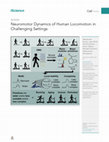
iScience, 2020
Is the control of movement less stable when we walk or run in challenging settings? Intuitively, ... more Is the control of movement less stable when we walk or run in challenging settings? Intuitively, one might answer that it is, given that challenging locomotion externally (e.g., rough terrain) or internally (e.g., age-related impairments) makes our movements more unstable. Here, we investigated how young and old humans synergistically activate muscles during locomotion when different perturbation levels are introduced. Of these control signals, called muscle synergies, we analyzed the local stability and the complexity (or irregularity) over time. Surprisingly, we found that perturbations force the central nervous system to produce muscle activation patterns that are less unstable and less complex. These outcomes show that robust locomotion control in challenging settings is achieved by producing less complex control signals that are more stable over time, whereas easier tasks allow for more unstable and irregular control.
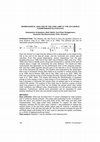
From the formula it is clear that the distance (W) is dependent on the height of the CM at the en... more From the formula it is clear that the distance (W) is dependent on the height of the CM at the end of the take-off phase, and the horizontal and vertical take-off velocities. From this causal dependency various researchers over the past decades (Hay et al. 1986; Koh & Hay 1990; Hay & Nohara 1990; Lees et al. 1993, 1994) have tried to identify which component (horizontal or vertical) of the take-off velocity plays a larger role concerning the jump distance. The results are often controversial and dependent on the performance level of the analyzed jumpers. Koh and Hay (1990) reported that the goal of the take-off is not to minimize the loss of the horizontal CM velocity. This position was supported by the observation that a loss in horizontal velocity often leads to an increase in vertical velocity (Hay et al. 1986; Hay & Nohara 1990; Koh & Hay 1990; Lees et al. 1993, 1994). For both men and women a loss of total energy has been reported (Witters et al. 1992; Lees et al. 1993, 1994). ...
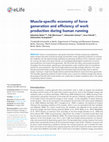
eLife, Sep 2, 2021
Human running features a spring-like interaction of body and ground, enabled by elastic tendons t... more Human running features a spring-like interaction of body and ground, enabled by elastic tendons that store mechanical energy and facilitate muscle operating conditions to minimize the metabolic cost. By experimentally assessing the operating conditions of two important muscles for running, the soleus and vastus lateralis, we investigated physiological mechanisms of muscle work production and muscle force generation. We found that the soleus continuously shortened throughout the stance phase, operating as work generator under conditions that are considered optimal for work production: high force-length potential and high enthalpy efficiency. The vastus lateralis promoted tendon energy storage and contracted nearly isometrically close to optimal length, resulting in a high force-length-velocity potential beneficial for economical force generation. The favorable operating conditions of both muscles were a result of an effective length and velocitydecoupling of fascicles and muscle-tendon unit, mostly due to tendon compliance and, in the soleus, marginally by fascicle rotation.
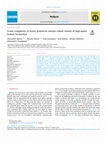
Heliyon, Oct 1, 2020
Walking and running are mechanically and energetically different locomotion modes. For selecting ... more Walking and running are mechanically and energetically different locomotion modes. For selecting one or another, speed is a parameter of paramount importance. Yet, both are likely controlled by similar lowdimensional neuronal networks that reflect in patterned muscle activations called muscle synergies. Here, we challenged human locomotion by having our participants walk and run at a very broad spectrum of submaximal and maximal speeds. The synergistic activations of lower limb locomotor muscles were obtained through decomposition of electromyographic data via non-negative matrix factorization. We analyzed the duration and complexity (via fractal analysis) over time of motor primitives, the temporal components of muscle synergies. We found that the motor control of high-speed locomotion was so challenging that the neuromotor system was forced to produce wider and less complex muscle activation patterns. The motor modules, or time-independent coefficients, were redistributed as locomotion speed changed. These outcomes show that humans cope with the challenges of high-speed locomotion by adapting the neuromotor dynamics through a set of strategies that allow for efficient creation and control of locomotion.

Pediatric Exercise Science, Nov 1, 2016
Purpose:To understand the mechanisms for the effects of resistance training on functional paramet... more Purpose:To understand the mechanisms for the effects of resistance training on functional parameters, and to assess the injury risk of the involved tissues, it is necessary to examine the underlying morphological and structural changes of the respective tissues.Methods:The presented information on physiological adaptations have been deduced from cross-sectional studies comparing youth athletes with controls and children with adults as well as from longitudinal studies examining the effects of resistance training in untrained children and adolescents and in youth athletes.Results:The evidence indicates, that training induced changes in motor performance rely partly on enhanced neuromuscular control, and partly on morphological adaptation of muscles and tendons, such as changes in muscle, muscle fiber and tendon cross-sectional area, muscle composition, and tendon material properties, with the bone also adapting by increasing bone mineral content and cortical area.Conclusion:Although the training induced adaptations of the investigated tissues follows similar principles in children as in adults, the magnitude of the adaptive response appears to be more subtle. As studies investigating physiological adaptation in youth athletes are sparse, more research in this area is warranted to elucidate the specific physiological stimulus-response relationship necessary for effective training programs and injury prevention.
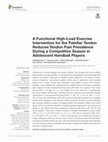
Frontiers in Physiology, Mar 10, 2021
Imbalances of muscle strength and tendon stiffness may increase the risk for patellar tendinopath... more Imbalances of muscle strength and tendon stiffness may increase the risk for patellar tendinopathy in growing athletes. The present study investigated if a functional high-load exercise intervention, designed to facilitate tendon adaptation and reduce muscletendon imbalances, may prevent patellar tendon pain in adolescent male handball players (12-14 years). Tendon pain prevalence (using VISA-P scores), knee extensor strength, vastus lateralis (VL) architecture and patellar tendon mechanical properties were measured at four measurement time points (M1-M4) over a season. The control group (CON; n = 18; age 13.1 ± 0.7 yrs, height 170 ± 8 cm, mass 58 ± 10 kg) followed the usual strength training plan, including muscular endurance and explosive strength components. In the experimental group (EXP; n = 16; 13.1 ± 0.6 yrs, 169 ± 11 cm, 58 ± 16 kg), two sessions per week with functional high-load exercises for the patellar tendon were integrated in the strength training schedule, aiming to provide repetitive high-intensity loading of at least 3 s loading duration per repetition. While in the control group 30% of the athletes reported a clinically significant aggravation of symptoms, all players in the experimental group remained or became pain-free at M2 until the end of the season. There was a similar increase of strength (normalized to body mass; CON: 3.1%, d = 0.22; EXP: 6.8%, d = 0.47; p = 0.04) and VL thickness (CON: 4.8%, d = 0.28; EXP: 5.7%, d = 0.32; p < 0.001) in both groups, but no significant changes of tendon stiffness or maximum tendon strain. Further, both groups demonstrated similar fluctuations of tendon strain over time. We conclude that functional high-load exercises can reduce the prevalence of patellar tendon pain in adolescent athletes even without a reduction of tendon strain.

Journal of Biomechanics, Sep 1, 2016
The accurate assessment of the Achilles tendon cross-sectional area (CSA) is a crucial prerequisi... more The accurate assessment of the Achilles tendon cross-sectional area (CSA) is a crucial prerequisite to investigate tendon adaptation and to calculate the tendon Young׳s modulus. Besides magnetic resonance imaging (MRI), ultrasonography emerged as an alternative imaging technique. The purpose of the present study was to assess the objectivity and reliability of the ultrasound-based methodology and its validity with respect to the established MRI-based assessment. The Achilles tendon CSA from 17 healthy males was assessed by ultrasonography at the proximal, medial and distal position five times each on two separate days and three observers segmented the CSAs. For the validation, MRI-based CSA measurements were provided accordingly. The analysis of the ultrasound-based method revealed significant observer and day effects (p&amp;amp;lt;0.05), despite high intra-class correlation coefficients for the three observers (&amp;amp;gt;0.93) and both days (&amp;amp;gt;0.89), respectively. The mean typical percentage error of both days was 7.1%. Comparing both methods, ultrasonography underestimated (19%) the CSA values obtained by MRI (p&amp;amp;lt;0.05). Although the correlation coefficients of both methods were high in all three positions (&amp;amp;gt;0.88), the respective absolute difference of in average 12mm2 and limits of agreement of up to +28mm2 and -2mm2 (~37% of the mean CSA) evidence considerable inconsistency. Besides the dependency of the CSA determination from the observer, the ultrasound method is not sensitive enough to detect physiological changes in tendon morphology of the magnitude that is reported by intervention studies. Furthermore, the validity analysis revealed a lack of agreement between both methods. Therefore, the ultrasound-based methodology cannot be recommended for an accurate Achilles tendon CSA determination in vivo.
Translational sports medicine, Sep 4, 2020
Low-back pain is a worldwide-recognized problem with dramatic consequences for the quality of lif... more Low-back pain is a worldwide-recognized problem with dramatic consequences for the quality of life of the affected people. 1,2 Epidemiological studies evidenced that all age groups, from teenagers to young and old adults, are affected by low-back pain. 2,3 In 85%-95% of the low-back patients, the diagnosis of a recognizable, specific pathology based on infection, structural deformity, or inflammatory disorder is lacking. 4 For this reason, all these patients are diagnosed with "non-specific" low-back pain. The absence of a clear and recognizable pathology results in a large variation of intervention outcomes. 5,6 Systematic reviews show that effect sizes of most treatments for non-specific low-back pain are

Deutsche Zeitschrift Fur Sportmedizin, Apr 1, 2019
Tendons are connective tissue working in unit with the muscle by transferring the generated force... more Tendons are connective tissue working in unit with the muscle by transferring the generated force to the skeletal system, and therewith enabling all kinds of movements (Fig. 1). The compliance of the tendinous tissue can considerably influence the forcelength and forcevelocity potential of the corresponding muscle, as well as provide elastic strain energy in a springlike manner (14, 27). During active loading of the muscletendon unit (MTU), the tendon may stretch and recoil, taking a proportion of the length changes of the MTU and providing mechanical work. Consequently, the muscle fascicles can operate with comparably smaller length changes compared to the MTU (19, 23), enabling favourable force generating conditions (7, 32, 36) (Fig. 1). This was concluded to be beneficial not only for maximum force outputs but also for economic force generation (36), yet a fine neu ral control of the muscletendon interaction (38)

Scientific Reports, Aug 22, 2019
perturbation-based exercise interventions challenge balance and improve reactive motor control. o... more perturbation-based exercise interventions challenge balance and improve reactive motor control. our purpose was to investigate the modular organisation during a standing balance task in both stable and unstable conditions to provide new insights into the neuromuscular control mechanisms needed to cope with perturbations. Fifteen participants performed 54 cycles of a specific task (i.e. pass from a double-to a single-leg standing) on stable ground and an unstable oscillating platform (Posturomed). Muscle synergies were extracted from the electromyographic activity of thirteen lower limb muscles. The maximum Lyapunov exponents of different body segments were calculated using kinematic data. We found two synergies functionally associated with the single-and double-leg stance in both stable and unstable conditions. Nonetheless, in the unstable condition participants needed an extra muscle synergy also functionally related to the single stance. Although a simple organisation of the neuromuscular system was sufficient to maintain the postural control in both conditions, the increased challenge in the oscillating platform was solved by adding one extra synergy. The addition of a new synergy with complementary function highlighted an increased motor output's robustness (i.e. ability to cope with errors) in the presence of perturbations.

The Journal of Experimental Biology, 2014
High strain magnitude and low strain frequency are important stimuli for tendon adaptation. Incre... more High strain magnitude and low strain frequency are important stimuli for tendon adaptation. Increasing the rate and duration of the applied strain may enhance the adaptive responses. Therefore, our purpose was to investigate the effect of strain rate and duration on Achilles tendon adaptation. The study included two experimental groups (N=14 and N=12) and a control group (N=13). The participants of the experimental groups exercised according to a reference protocol (14 weeks, four times a week), featuring a high strain magnitude (~6.5%) and a low strain frequency (0.17 Hz, 3 s loading/3 s relaxation) on one leg and with either a higher strain rate (one-legged jumps) or a longer strain duration (12 s loading) on the other leg. The strain magnitude and loading volume were similar in all protocols. Before and after the interventions, the tendon stiffness, Young's modulus and cross-sectional area were examined using magnetic resonance imaging, ultrasound and dynamometry. The reference and long strain duration protocols induced significantly increased (P<0.05) tendon stiffness (57% and 25%), cross-sectional area (4.2% and 5.3%) and Young's modulus (51% and 17%). The increases in tendon stiffness and Young's modulus were higher in the reference protocol. Although region-specific tendon hypertrophy was also detected after the high strain rate training, there was only a tendency of increased stiffness (P=0.08) and cross-sectional area (P=0.09). The control group did not show any changes (P=0.86). The results provide evidence that a high strain magnitude, an appropriate strain duration and repetitive loading are essential components for an efficient adaptive stimulus for tendons.
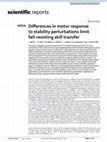
Scientific Reports, Dec 19, 2022
This study investigated transfer of improvements in stability recovery performance to novel pertu... more This study investigated transfer of improvements in stability recovery performance to novel perturbations. Thirty adults (20-53 yr) were assigned equally to three treadmill walking groups: groups exposed to eight trip perturbations of either low or high magnitude and a third control group that walked unperturbed. Following treadmill walking, participants were exposed to stability loss from a forward-inclined position (lean-and-release) and an overground trip. Lower limb joint kinematics for the swing phase of recovery steps was compared for the three tasks using statistical parametric mapping and recovery performance was analysed by margin of stability and base of support. The perturbation groups improved stability (greater margin of stability) over the eight gait perturbations. There was no group effect for stability recovery in lean-and-release. For the overground trip, both perturbation groups showed similar enhanced stability recovery (margin of stability and base of support) compared to controls. Differences in joint angle kinematics between treadmill-perturbation and lean-and-release were more prolonged and greater than between the two gait perturbation tasks. This study indicates that: (i) practising stability control enhances human resilience to novel perturbations; (ii) enhancement is not necessarily dependent on perturbation magnitude; (iii) differences in motor response patterns between tasks may limit transfer. Human locomotion frequently faces a variety of perturbations to stability that provoke adjustments to maintain postural integrity and avoid falls. It has been suggested that the central nervous system monitors and corrects motor responses based on the prediction of sensory consequences of perturbations 1. This must, however, be accurate to the nature of perturbation, and motor control is therefore constantly refined based on error-feedback information 2,3. In mechanical terms, the system uses an internal representation of the centre of mass (CoM) in relation to the base of support (BoS) based on prior experience 4,5. If exposed to perturbations which lead to excursion of the CoM beyond the boundaries of the BoS (a state of instability 6,7), such information will be received, and appropriate motor responses follow, to regain the desired state of the CoM, i.e. a stable body configuration. Given such capability of neuromotor processing, recovery responses adapted from exercised exposure to perturbations could enhance coping with altered forms of the exercised perturbation 8-11. Based on these assumptions, developing stability control through repeatedly perturbing locomotion has been recognised as an important paradigm for acquisition of general skills for resisting falls in daily life 12,13. Extensive research studies have attempted to mimic real-life situations of postural threat during locomotion in an exercise context (e.g. trips or slips). These indicate that single sessions comprising repeated perturbations can elicit acute and retainable improvements in stability control in adults across the lifespan 9,14-18. Transfer of such exercise-induced stability improvements to altered forms of the exercised perturbations has been revealed previously 9,10,16-18 , and reported to reduce falls incidence in the daily lives of community-dwelling adults 19,20-although not for all types of falls. Those results are in line with the general assumption that such skill transfer relies on commonality of contextual sensory feedback between exercised and non-exercised perturbations, requiring only that the system fine tunes the adapted motor response 9,11,21. If the context of perturbation differs, the system needs to adjust its adapted motor response to the novel task constraints to achieve positive transfer. Such might be readily achieved if the different perturbations elicit some degree of shared stability response for recovery. In our three recent studies 15,22,23 we could not, however, show functionally relevant matching 22 or performance transfer from repeated treadmill-based gait perturbations 15,23 to a clinical fall-risk assessment in the form of a lean-and-release task 24. Performance transfer failed to occur even though both tasks shared the same
bioRxiv (Cold Spring Harbor Laboratory), Sep 26, 2022
Journal of Biomechanics, Jul 1, 2012

Sports Medicine - Open, Dec 1, 2022
Background: Assuming that the mechanisms inducing adaptation in healthy tendons yield similar res... more Background: Assuming that the mechanisms inducing adaptation in healthy tendons yield similar responses in tendinopathic tendons, we hypothesized that a high-loading exercise protocol that increases tendon stiffness and cross-sectional area in male healthy Achilles tendons may also induce comparable beneficial adaptations in male tendinopathic Achilles tendons in addition to improving pain and function. Objectives: We investigated the effectiveness of high-loading exercise in Achilles tendinopathy in terms of inducing mechanical (tendon stiffness, maximum strain), material (Young's modulus), morphological (tendon cross-sectional area (CSA)), maximum voluntary isometric plantar flexor strength (MVC) as well as clinical adaptations (Victorian Institute of Sports Assessment-Achilles (VISA-A) score and pain (numerical rating scale (NRS))) as the primary outcomes. As secondary outcomes, drop (DJ) and counter-movement jump (CMJ) height and intratendinous vascularity were assessed. Methods: We conducted a controlled clinical trial with a 3-month intervention phase. Eligibility criteria were assessed by researchers and medical doctors. Inclusion criteria were male sex, aged between 20 and 55 years, chronic Achilles tendinopathy confirmed by a medical doctor via ultrasound-assisted assessment, and a severity level of less than 80 points on the VISA-A score. Thirty-nine patients were assigned by sequential allocation to one of three parallel arms: a high-loading intervention (training at ~ 90% of the MVC) (n = 15), eccentric exercise (according to the Alfredson protocol) as the standard therapy (n = 15) and passive therapy (n = 14). Parameters were assessed pre-and-postintervention. Data analysis was blinded. Results: Primary outcomes: Plantar flexor MVC, tendon stiffness, mean CSA and maximum tendon strain improved only in the high-loading intervention group by 7.2 ± 9.9% (p = 0.045), 20.1 ± 20.5% (p = 0.049), 8.98 ± 5.8% (p < 0.001) and −12.4 ± 10.3% (p = 0.001), respectively. Stiffness decreased in the passive therapy group (−7.7 ± 21.2%; p = 0.042). There was no change in Young's modulus in either group (p > 0.05). The VISA-A score increased in all groups on average by 19.8 ± 15.3 points (p < 0.001), while pain (NRS) dropped by −0.55 ± 0.9 points (p < 0.001). Secondary
Sensors, Nov 6, 2021
This article is an open access article distributed under the terms and conditions of the Creative... more This article is an open access article distributed under the terms and conditions of the Creative Commons Attribution (CC BY
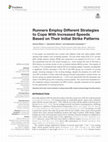
Frontiers in Physiology, Nov 2, 2021
In this paper we examined how runners with different initial foot strike pattern (FSP) develop th... more In this paper we examined how runners with different initial foot strike pattern (FSP) develop their pattern over increasing speeds. The foot strike index (FSI) of 47 runners [66% initially rearfoot strikers (RFS)] was measured in six speeds (2.5-5.0 ms −1), with the hypotheses that the FSI would increase (i.e., move toward the fore of the foot) in RFS strikers, but remain similar in mid-or forefoot strikers (MFS) runners. The majority of runners (77%) maintained their original FSP by increasing speed. However, we detected a significant (16.8%) decrease in the FSI in the MFS group as a function of running speed, showing changes in the running strategy, despite the absence of a shift from one FSP to another. Further, while both groups showed a decrease in contact times, we found a group by speed interaction (p < 0.001) and specifically that this decrease was lower in the MFS group with increasing running speeds. This could have implications in the metabolic energy consumption for MFS-runners, typically measured at low speeds for the assessment of running economy.
Scandinavian Journal of Medicine & Science in Sports, Dec 27, 2013

Sports Medicine - Open, Mar 27, 2015
Background: The present article systematically reviews recent literature on the in vivo adaptatio... more Background: The present article systematically reviews recent literature on the in vivo adaptation of asymptomatic human tendons following increased chronic mechanical loading, and meta-analyzes the loading conditions, intervention outcomes, as well as methodological aspects. Methods: The search was performed in the databases PubMed, Web of Knowledge, and Scopus as well as in the reference lists of the eligible articles. A study was included if it conducted (a) a longitudinal exercise intervention (≥8 weeks) on (b) healthy humans (18 to 50 years), (c) investigating the effects on mechanical (i.e., stiffness), material (i.e., Young's modulus) and/or morphological properties (i.e., cross-sectional area (CSA)) of tendons in vivo, and was reported (d) in English language. Weighted average effect sizes (SMD, random-effects) and heterogeneity (Q and I 2 statistics) of the intervention-induced changes of tendon stiffness, Young's modulus, and CSA were calculated. A subgroup analysis was conducted regarding the applied loading intensity, muscle contraction type, and intervention duration. Further, the methodological study quality and the risk of bias were assessed. Results: The review process yielded 27 studies with 37 separate interventions on either the Achilles or patellar tendon (264 participants). SMD was 0.70 (confidence interval: 0.51, 0.88) for tendon stiffness (N=37), 0.69 (0.36, 1.03) for Young's modulus (N=17), and 0.24 (0.07, 0.42) for CSA (N=33), with significant overall intervention effects (p<0.05). The heterogeneity analysis (stiffness: I 2 =30%; Young's modulus: I 2 =57%; CSA: I 2 =21%) indicated that differences in the loading conditions may affect the adaptive responses. The subgroup analysis confirmed that stiffness adaptation significantly (p<0.05) depends on loading intensity (I 2 =0%), but not on muscle contraction type. Although not significantly different, SMD was higher for interventions with longer duration (≥12 weeks). The average score of 71±9% in methodological quality assessment indicated an appropriate quality of most studies. Conclusions: The present meta-analysis provides elaborate statistical evidence that tendons are highly responsive to diverse loading regimens. However, the data strongly suggests that loading magnitude in particular plays a key role for tendon adaptation in contrast to muscle contraction type. Furthermore, intervention-induced changes in tendon stiffness seem to be more attributed to adaptations of the material rather than morphological properties.
bioRxiv (Cold Spring Harbor Laboratory), Mar 23, 2023
The study provides experimental evidence that the human soleus muscle favors contractile conditio... more The study provides experimental evidence that the human soleus muscle favors contractile conditions for economical work production during submaximal running and for enhancing mechanical power production during maximal running speed.










Uploads
Papers by Adamantios Arampatzis